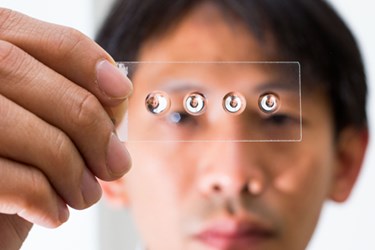Ultra Cheap Lenses Could Turn Smartphones Into Portable Microscopes
By Joel Lindsey

Along with a small group of researchers, Australian National University engineer Steve Lee has discovered a way to potentially transform smartphones into microscopes using simple lenses that could be manufactured for less than a penny apiece.
“Our hanging droplet lens fabrication technique heralds a new paradigm in low cost, high performance optical lenses for the masses,” Lee wrote in an article published recently in the journal Biomedical Optics Express. “Using these lenses, we were able to transform an ordinary commercial smartphone camera into a low-cost digital dermascope that can readily visualize microscopic structures on skin such as sweat pores.”
According to a news article published in The Australian, Lee stumbled onto the new lens fabrication technique by accident while researching implantable microscopes. The technique is so simple that Lee and other scientists involved with the project have said that amateur enthusiasts could potentially make lenses at home.
Lee and his team created the new lenses by first placing a small droplet of polydimethylsiloxane (PDMS) — a common, gel-like silicone polymer — onto a glass microscope slide. The droplet was then baked in an oven at 70 degrees Celsius to form a hard base layer. Another droplet of PDMS was then added, and the slide was flipped upside down. The force of gravity pulled this new layer into a parabolic shape, and the entire thing was baked once again, creating a tiny, curved, transparent lens with significant magnification capabilities.
The lens was then attached to a smartphone camera using a plastic attachment designed by the team and generated on a 3D printer. The entire device cost around two dollars.
“What I did was to systematically fine-tune the curvature that’s formed by a simple droplet with the help of gravity, and without any molds,” Lee said in a press release published by The Optical Society. “We’re quite surprised at the magnification enhancement using such a simple process. Simple optics can be very powerful.”
Lee’s research group said that the new lenses could be particularly helpful as a way of creating ultra cheap, highly mobile dermascopes to help doctors diagnose skin diseases like melanoma in economically underprivileged and remote rural areas. They could also be used as implantable lenses for in vivo laboratory use.
The research team continues to fine-tune the design, size, and effectiveness of the new lenses. They are also working with a German manufacturer to begin mass-producing cheap lens attachments for smartphones with the hopes of beginning production in three to six months, according to The Australian.
Image Credit: Stuart Hay
